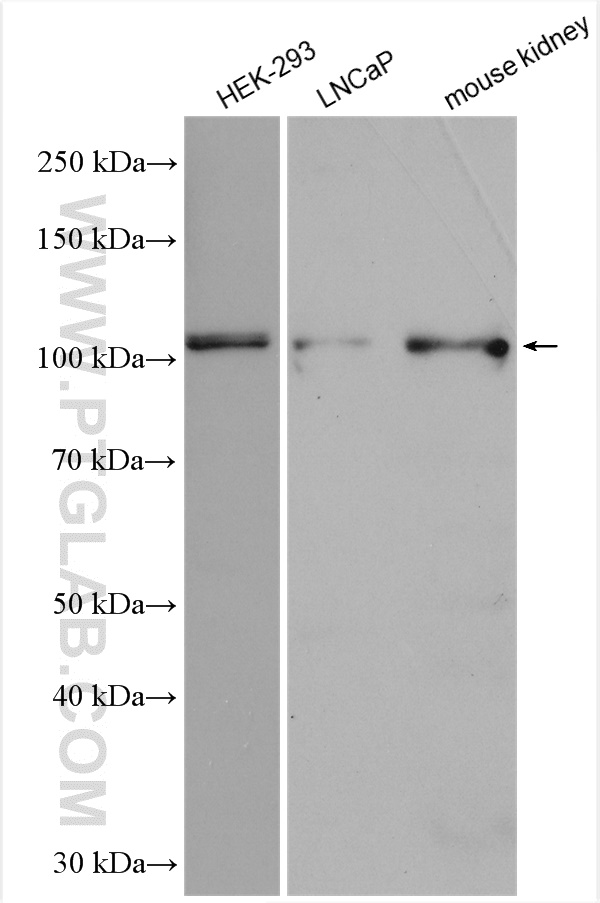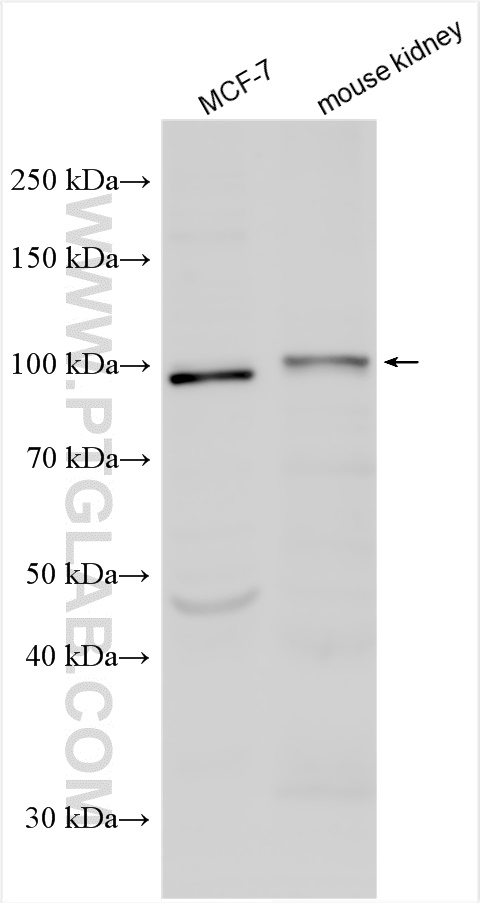验证数据展示
经过测试的应用
| Positive WB detected in | HEK-293 cells, MCF-7 cells, LNCaP cells, mouse kidney tissue |
推荐稀释比
| 应用 | 推荐稀释比 |
|---|---|
| Western Blot (WB) | WB : 1:500-1:2000 |
| It is recommended that this reagent should be titrated in each testing system to obtain optimal results. | |
| Sample-dependent, Check data in validation data gallery. | |
产品信息
26827-1-AP targets SLC12A9 in WB, ELISA applications and shows reactivity with human, mouse samples.
| 经测试应用 | WB, ELISA Application Description |
| 经测试反应性 | human, mouse |
| 免疫原 |
CatNo: Ag25351 Product name: Recombinant human SLC12A9 protein Source: e coli.-derived, PET30a Tag: 6*His Domain: 417-538 aa of BC000154 Sequence: QALLFHQVRKYLLRLDVRKDHVKFWRPQLLLLVGNPRGALPLLRLANQLKKGGLYVLGHVTLGDLDSLPSDPVQPQYGAWLSLVDRAQVKAFVDLTLSPSVRQGAQHLLRISGLESNSHPLP 种属同源性预测 |
| 宿主/亚型 | Rabbit / IgG |
| 抗体类别 | Polyclonal |
| 产品类型 | Antibody |
| 全称 | solute carrier family 12 (potassium/chloride transporters), member 9 |
| 别名 | CCC interacting protein 1, CCC6, CIP1, hCCC6, hCIP1, SLC12A9, WO3.3 |
| 计算分子量 | 96 kDa |
| 观测分子量 | 101 kDa |
| GenBank蛋白编号 | BC000154 |
| 基因名称 | SLC12A9 |
| Gene ID (NCBI) | 56996 |
| RRID | AB_3085908 |
| 偶联类型 | Unconjugated |
| 形式 | Liquid |
| 纯化方式 | Antigen affinity purification |
| UNIPROT ID | Q9BXP2 |
| 储存缓冲液 | PBS with 0.02% sodium azide and 50% glycerol, pH 7.3. |
| 储存条件 | Store at -20°C. Stable for one year after shipment. Aliquoting is unnecessary for -20oC storage. |
背景介绍
SLC12A9, also known as CCC6 and CIP1, belongs to the SLC12A transporter family. SLC12A9 encodes a 914 amino acid protein with predicted 12 TM domains, two N-glycosylation sites between TM5 and TM6, and a carboxyl terminus PKC phosphorylation site (PMID: 23506871). SLC12A9 regulates ion gradients across renal tubules and maintains cell volume (PMID: 27530302). SLC12A9 is highly expressed in placenta, brain, and kidney.
实验方案
| Product Specific Protocols | |
|---|---|
| WB protocol for SLC12A9 antibody 26827-1-AP | Download protocol |
| Standard Protocols | |
|---|---|
| Click here to view our Standard Protocols |



